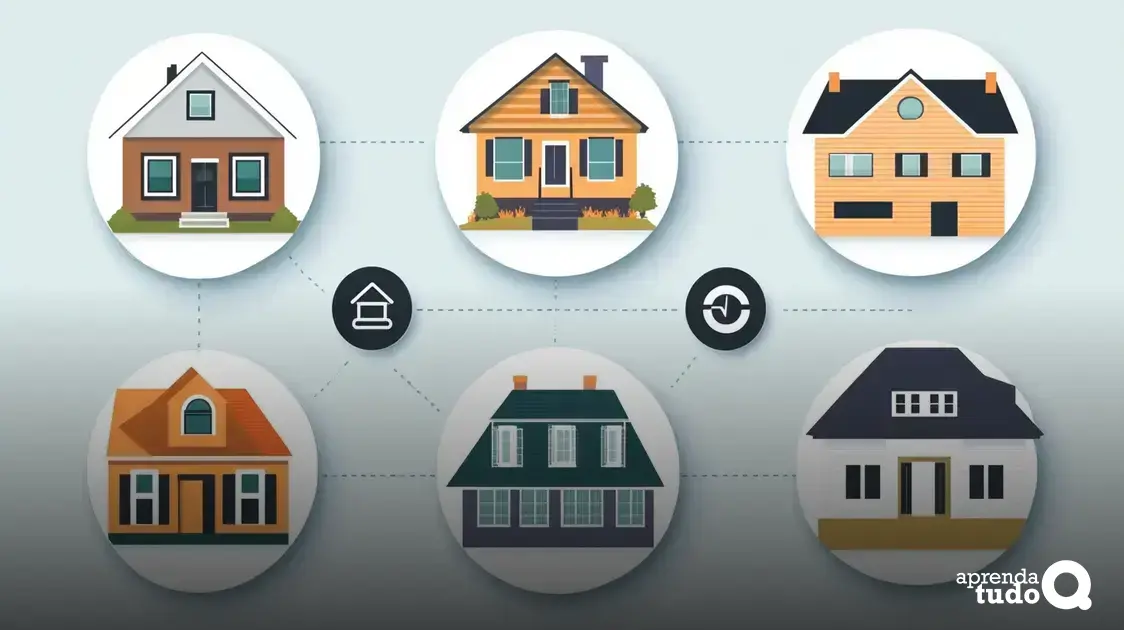First-time home loans are tailored for first-time buyers, making home ownership accessible and exciting.
Understanding these options can greatly impact your purchase journey.
Whether you’re a young professional or a growing family, navigating the world of finance for your first home can feel overwhelming, but with the right guidance, it can be a rewarding experience.
Understanding First-Time Home Loans
Understanding first-time home loans is crucial for anyone looking to buy their first home.
These loans are designed specifically for first-time buyers and offer unique benefits that cater to your needs.
They often come with lower down payments and more lenient credit requirements, making home ownership more achievable.
What Makes First-Time Home Loans Different?
Unlike traditional home loans, first-time home loans are aimed at assisting buyers who have never owned a home before.
This means that lenders are more flexible in their terms and conditions.
You may also qualify for government-backed loans, such as FHA or USDA loans, which typically offer reduced interest rates and lower upfront costs.
Benefits of First-Time Home Loans
Some benefits of these loans include:
- Lower down payment options, sometimes as low as 3.5%.
- More forgiving credit score standards.
- Access to special programmes and grants for down payments in certain areas.
- Possibility to include closing costs in the loan amount.
Understanding the application process for these loans is also key.
First-time buyers need to prepare their financial documents, such as tax returns, bank statements, and proof of income, which will help lenders assess your financial stability.
Research and Planning is Essential
Before applying for a first-time home loan, it’s wise to do thorough research. Look into various loan types, interest rates, and terms.
Consider reaching out to financial advisors or lenders who specialise in first-time home loans. This will give you a clearer idea of what suits your financial situation.
Additionally, getting pre-approved can give you an edge in the home-buying process, making your offers more appealing to sellers.
With proper understanding and planning, navigating the world of first-time home loans can be a less daunting experience.
Eligibility Criteria for First-Time Home Loans
The eligibility criteria for first-time home loans are key to determining if you can secure financing for your dream home. Understanding these requirements is essential in your home-buying journey.
Common Eligibility Requirements
Typically, the following criteria must be met:
- Credit Score: Most lenders look for a credit score of at least 620, although some government-backed loans may accept lower scores.
- Income: Consistent employment and a stable income are important. Lenders will assess your debt-to-income ratio, which should ideally be below 43%.
- Down Payment: While traditional loans may require a 20% down payment, first-time home loans can start as low as 3.5%.
- Residency: You must be a permanent resident or citizen of your country to qualify for most first-time home loans.
- First-Time Buyer Status: To be considered a first-time buyer, you must not have owned a home in the last three years.
Special Considerations for Government-Backed Loans
If you are considering government-backed loans like FHA, VA, or USDA, you may find additional eligibility requirements. For instance:
- FHA Loans: Require a minimum down payment of 3.5% and mortgage insurance for the life of the loan.
- VA Loans: Available exclusively to veterans and active-duty military, these loans require no down payment and have competitive rates.
- USDA Loans: Designed for rural areas, these loans require zero down payment and have specific income limits.
Documentations Required
When applying for a first-time home loan, be prepared to provide documentation such as:
- Proof of income (pay stubs, tax returns).
- Bank statements.
- Identification (driver’s licence or passport).
- Credit history reports.
Meeting these eligibility criteria can significantly improve your chances of getting approved for a first-time home loan, helping you step closer to home ownership.
Types of First-Time Home Loans

There are various types of first-time home loans available, each catering to different needs and financial situations.
Understanding these options can help you select the best one for your circumstances.
1. FHA Loans
FHA loans are popular among first-time home buyers. They are backed by the Federal Housing
Administration, allowing for lower down payments, sometimes as low as 3.5%. A credit score of 580 is generally required to qualify.
2. VA Loans
If you are a veteran or active-duty military, VA loans are a fantastic option. These loans require no down payment and offer competitive interest rates.
No mortgage insurance is needed, making them an affordable choice.
3. USDA Loans
USDA loans are ideal for those looking to buy in rural areas. They also offer zero down payment options and have income limits based on the location of the home.
This makes it a great choice for low to moderate-income buyers.
4. Conventional Loans
While these are not government-backed, conventional loans can be an option if you have a strong credit score and can manage a down payment of at least 5%.
They often provide more flexibility than government-backed loans.
5. Fixed-Rate Mortgages
A fixed-rate mortgage keeps your interest rate the same for the entire term of the loan.
This gives you predictability in your monthly payments, making budgeting easier.
6. Adjustable-Rate Mortgages (ARM)
ARMs start with a lower interest rate that adjusts after a set period.
While this can mean lower initial payments, it may lead to higher costs later if rates rise, so it’s important to consider your long-term plans.
Understanding these various types of first-time home loans is essential for making informed decisions on the best path to homeownership.
How to Apply for First-Time Home Loans
Applying for first-time home loans can seem daunting, but breaking it down into steps makes it more manageable.
Follow these simple steps to guide you through the application process.
1. Check Your Credit Score
Start by obtaining a copy of your credit report. Knowing your score helps you understand your financial standing and determine which loan types you qualify for.
Aim for a score above 620 for many first-time home loan options.
2. Gather Necessary Documents
Before applying, you will need to collect important documents such as:
- Proof of income (recent pay stubs, tax returns).
- Bank statements (checking and savings).
- Identification (government-issued ID).
3. Determine Your Budget
Calculate how much you can afford for monthly payments.
Consider your income, current expenses, and any additional costs related to homeownership, such as property taxes and insurance.
4. Shop for Lenders
Research different lenders and compare their rates, terms, and fees.
Consider getting quotes from at least three lenders to find the best fit for your financial situation.
5. Get Pre-Approved
Getting pre-approved for a loan gives you an idea of how much money you can borrow. This will help you make stronger offers when you find a home you like.
Lenders will review your financial documentation and run a credit check during this process.
6. Complete the Loan Application
Once you choose a lender, complete their loan application form.
Ensure all information is accurate, as any discrepancies can cause delays in approval.
7. Provide Additional Documents
After submitting your application, your lender may request additional documentation. Respond promptly to any requests to keep the process moving smoothly.
8. Wait for Approval
Your lender will evaluate your application and assess your financial history. Approval can take several days to weeks. Be patient during this time and stay in touch with your lender for updates.
9. Review the Loan Terms
Once approved, carefully review the loan terms. Pay attention to interest rates, monthly payments, and any fees associated with the loan.
Make sure you fully understand your obligations before accepting the loan.
10. Closing the Loan
If you agree to the terms, you will sign the loan documents at the closing meeting. After this, you will receive the funds needed to buy your home!
By following these steps, you can confidently navigate the process of applying for first-time home loans, bringing you closer to your goal of homeownership.
Tips for Getting Approved
Getting approved for a first-time home loan can be a smooth process if you follow some essential tips.
Use the following advice to strengthen your application and increase your chances of approval.
1. Maintain a Good Credit Score
Your credit score plays a significant role in loan approval. Aim for a score of at least 620.
Check your credit report for any errors and work on paying off debts to improve your score.
2. Save for a Larger Down Payment
A larger down payment can lower your loan-to-value ratio, making you a more attractive candidate for lenders.
Consider putting down at least 5% to 20% if your budget allows.
3. Reduce Your Debt-to-Income Ratio
Lenders assess your monthly debt compared to your income. Keeping your debt-to-income ratio below 43% will help you qualify for a loan more easily.
Focus on paying down credit cards and other debts.
4. Provide Accurate Information
Ensure all information on your application is accurate and complete. Any inconsistencies may raise flags during the approval process.
Double-check your application and provide all required documentation.
5. Get Pre-Approved
Before house-hunting, get pre-approved for a loan.
This indicates to sellers that you’re serious and financially capable of purchasing a home, making your offers stronger.
6. Have a Stable Employment History
Lenders prefer applicants with stable employment.
Aim to show at least two years of employment in the same field, which demonstrates reliability and financial stability.
7. Engage with a Reliable Mortgage Broker
A mortgage broker can guide you through the approval process.
They can help you find the best loan options and give valuable insights based on their experience with different lenders.
8. Be Prepared for Extra Documentation
The approval process may require additional documents.
Be ready to submit items like bank statements, tax returns, and proof of income as needed to expedite your application.
9. Keep Open Communication with Your Lender
Stay in touch with your lender throughout the application process. Ask questions and provide any updates on your financial situation promptly.
By following these tips, you can enhance your chances of getting approved for your first-time home loan and successfully embark on your homeownership journey.
Common Mistakes to Avoid with First-Time Home Loans

When applying for first-time home loans, avoiding common mistakes can save you time and money. Here are some pitfalls to steer clear of:
1. Ignoring Your Credit Score
Your credit score is crucial in the loan approval process. Many first-time buyers neglect to check their score before applying, which can lead to surprises later.
Always review your credit report and address any issues before submitting your application.
2. Not Shopping Around
Some buyers settle for the first lender they talk to, missing out on better rates and terms. Take the time to shop around and compare multiple lenders.
Different lenders can offer various rates and fees that might work better for you.
3. Underestimating Overall Costs
Many first-time buyers focus solely on the down payment, forgetting other costs such as closing costs, property taxes, and homeowner’s insurance.
Make sure to account for all expenses to avoid financial strain later.
4. Making Large Purchases Before Closing
Buying a car or furniture before closing can change your financial situation drastically. Lenders assess your credit and financial state right up to closing.
Big purchases can affect your debt-to-income ratio and may jeopardise your loan approval.
5. Failing to Get Pre-Approved
Some buyers skip the pre-approval process, thinking it’s unnecessary. Pre-approval shows sellers you’re serious and financially capable.
It also provides a clearer picture of your budget when house hunting.
6. Overextending Your Budget
Be careful not to stretch your budget too thin. It’s easy to fall in love with a home and ignore financial constraints.
Remember to stick to a budget that won’t put unnecessary stress on your finances.
7. Rushing the Process
Home buying is a significant commitment. Rushing can lead to mistakes like overlooking defects in the property or missing vital steps in the application process.
Take your time to ensure every detail is correct.
8. Not Seeking Professional Help
Many first-time buyers believe they can navigate the process alone, leading to costly mistakes.
Working with a knowledgeable realtor or mortgage advisor can provide valuable insights and help you avoid common pitfalls.
9. Forgetting to Budget for Maintenance
Owning a home comes with maintenance costs. First-time buyers often overlook these expenses, thinking their mortgage is their only financial obligation.
Create a budget for upkeep and repairs to avoid surprises down the line.
Avoiding these common mistakes can help you navigate the process of securing a first-time home loan more smoothly and successfully.
Embarking on Your Journey to Homeownership
Understanding the landscape of first-time home loans is essential for achieving your dream of homeownership.
From grasping the types of loans available to navigating the application process and avoiding common pitfalls, each step plays a vital role.
By staying informed, monitoring your credit, shopping around for the best deals, and being prepared, you can confidently tackle the challenges ahead.
Remember, it’s not just about securing a loan; it’s about making a sound financial decision that brings you closer to your ideal home.
Utilising the tips provided and being mindful of the common mistakes can significantly enhance your chances of approval and ultimately lead you to a successful purchase.
With diligence and planning, owning your first home can become a rewarding reality.






